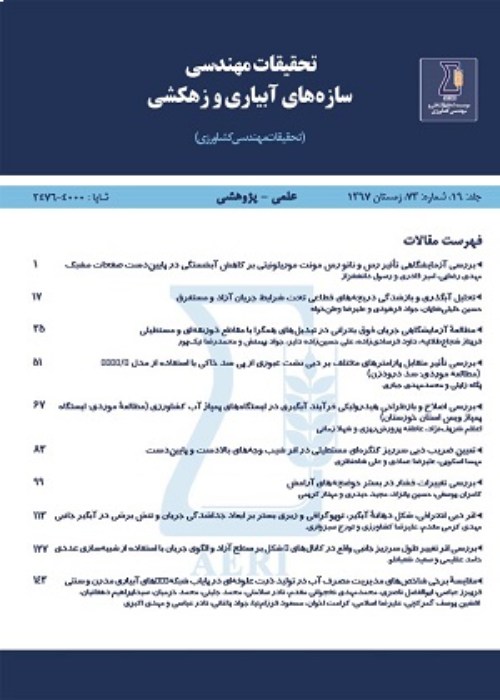Water Requirement and Water Productivity of Rosa Damascene Mill. in Double Row Drip Irrigation System by Soil Water Balance Method in Ghamsar Region
Rosa Damascene Mill. is cultivated in the most parts of Iran. This flowers are worldwide well known for their fine fragrance and are harvested to produce rose oil used in perfumery or to make rose water. Due to the lack of water resources in the world, especially in arid and semi-arid areas such as Iran, accurate estimates of the crop water requirements are necessary and essential for planning and managing irrigation events in the field. One method among the many available ones for estimating the crop evapotranspiration is the use of the reference evapotranspiration (grass) and crop coefficients. Crop coefficients can be variable due to the differences in plant variety, climatic conditions and the type of water, soil and plant managements. Therefore, for a more accurate estimate of crop evapotranspiration, local crop coefficients should be derived and used. The purpose of this research is to determine the crop coefficients of the Rosa Damascene Mill. under a two-row drip irrigation system using the soil water balance method in the Ghamsar region.
This research was conducted during 2022 in a 53-hectare Rosa Damascene Mill. farm in the Ghamsar city. The soil moisture content prior and after each irrigation event was measured by gravimetric method. The actual evapotranspiration of the Rosa Damascene Mill. was calculated during the growing season as the residual term of the soil water balance equation. The crop coefficient was obtained by dividing the actual evapotranspiration of the Rosa Damascene Mill. by the reference evapotranspiration. ET0 Calculator and Crop Wat software were used to calculate reference evapotranspiration by the FAO- Penman- Monteith equation using the daily meteorological data recorded at the nearest weather station. In order to evaluate the usefulness of the irrigation water consumed, the water productivity indicators were determined. Using 8 volumetric flow meters that were installed at the beginning of 8 irrigation trickle lateral pipes in different parts of the field, the volume of water entering 4 control-rows of Rosa Damascene Mill. during the growing season was measured. Also, harvested flowers of the Rosa Damascene Mill. (YC) in each one of these control-rows were weighed separately and irrigation water productivity and water use productivity were determined for each one of the control-rows.
The Crop Wat and ET0 Calculator software estimated the seasonal reference evapotranspiration during the growing season to be 1147 and 1155 mm, respectively. The depth of water consumed by the Rosa Damascene Mill. in the wetted area by the water coming out of the emitters during the 188-day growing season of Rosa Damascene Mill. was 997 mm. The cumulative depth of water infiltrated into the wetted area was equal to 1017 mm. It should be noted that the depth of water consumption in the wetted area is not equal to the actual evapotranspiration of the Rosa Damascene Mill., because the actual evapotranspiration of the crop was calculated per unit of field area (sum of wetted and non- wetted areas), while the depth of water consumption in the wetted area was calculated. The minimum and maximum crop coefficients during the growing season were 0.6 and 1.2, respectively. The weight of the wet Rosa Damascene Mill. flower harvested from the entire farm, which is about 40 hectares cultivated out of the 53 hectares total, was equal to 130 tons. Therefore, the average yield of wet Rosa Damascene Mill. flower in the 40 hectares cultivated area was 3.25 tons per hectare. The highest amount of irrigation water productivity obtained from a control-row was 0.81 kg/m3. The average yield of Rosa Damascene Mill. flower in the evaluated control-rows was 48.25 kg per row, where the average irrigation water productivity was 0.78 kg/m3.
The reported crop coefficient values in the Karaj region are higher than the crop coefficient values obtained in the Ghamsar region during most of the growing season. This difference can be attributed to the differences in the climate and the type of irrigation system used, the type of crop variety, and the way the crop was managed. With the increase of irrigation volume in the studied rows, it was observed that the yield and irrigation water productivity increased. By generalizing the conditions of the control-row A to the whole farm, it was determined that if the whole farm was irrigated with a volume of 156,000 m3 during the growing season, the yield of the whole farm would had reached about 130 tons. By generalizing the conditions of control-row D to the whole farm, it was determined that if the whole farm was irrigated during the growing season with a volume of 148,725 m3, the yield of the whole farm would had been about 110 tons. Therefore, by saving 7275 m3 of irrigation water, the yield of the entire farm would decrease by about 20 tons.
- حق عضویت دریافتی صرف حمایت از نشریات عضو و نگهداری، تکمیل و توسعه مگیران میشود.
- پرداخت حق اشتراک و دانلود مقالات اجازه بازنشر آن در سایر رسانههای چاپی و دیجیتال را به کاربر نمیدهد.


